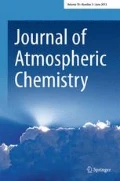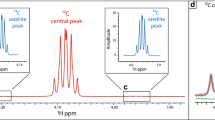Abstract
Large carbon kinetic isotope effects (KIEs) were measured for reactions of methyl bromide (MeBr), methyl chloride (MeCl), and methyl iodide (MeI) with various nucleophiles at 287 and 306 K in aqueous solutions. Rates of reaction of MeBr and MeI with H2O (neutral hydrolysis) or Cl− (halide substitution) were consistent with previous measurements. Hydrolysis rates increased with increasing temperature or pH (base hydrolysis). KIEs for hydrolysis were 51 ± 6%0 for MeBr and 38 ± 8%0 for MeI. Rates of halide substitution increased with increasing temperature and greater reactivity of the attacking nucleophile, with the fastest reaction being that of MeI with Br−. KIEs for halide substitution were independent of temperature but varied with the reactant methyl halide and the attacking nucleophile. KIEs were similar for MeBr substitution with Cl− and MeCl substitution with Br− (57 ± 5 and 60 ± 9%0, respectively). The KIE for halide exchange of MeI was lower overall (33 ± 8%0) and was greater for substitution with Br− (46 ± 6%0) than with Cl− (29 ± 6%0).
Similar content being viewed by others
References
Bill, M., Rhew, R. C., Weiss, R. F., and Goldstein, A. H., 2002a: Carbon isotope ratios of methyl bromide and methyl chloride emitted from a coastal salt marsh, Geophys. Res. Lett. 29(4), doi:10.1029/2001GL012946
Bill, M., Miller, L. G., and Goldstein, A. H., 2002b: Carbon isotope fractionation of methyl bromide during agricultural soil fumigations, Biogeochemistry 60, 181–190.
Bill, M., Conrad, M. E., and Goldstein, A. H., 2004: Stable carbon isotope composition of atmospheric methyl bromide, Geophys. Res. Lett. 31, L04109, doi:10.1029/2003GL018639
Blake, N. J., Blake D. R., Sive, B. B., Chen, T.-Y., Rowland, F. S., Collins Jr., J. E., Sachse, G. W., and Anderson, B. E., 1996: Biomass burning emissions and vertical distribution of atmospheric methyl halides and other reduced carbon gases in the South Atlantic region, J. Geophys. Res. 101, 24,151–24,164.
Connell, T. L., Joye, S. B., Miller, L. G., and Oremland, R. S., 1997: Bacterial oxidation of methyl bromide in Mono Lake, California, Environ. Sci. and Technol. 31, 1489–1495.
Elliott, S. and Rowland, F. S., 1993: Nucleophilic substitution rates and solubilities for methyl halides in seawater, Geophys. Res. Lett. 20, 1043–1046.
Elliott, S. M. and Rowland, F. S., 1995: Methyl halide hydrolysis rates in natural waters, J. Atmos. Chem. 20, 229–236.
Gentile, I. A., Ferraris, L., Crespi, S., and Belligno, A., 1989: The degradation of methyl bromide in some natural fresh waters. Influence of temperature, pH, and light, Pestic. Sci. 25, 261–272.
Hamilton, J. T. G., McRoberts, W. C., Keppler, F., Kalin, R. M., and Harper, D. B., 2003: Chloride methylation by plant pectin: An efficient environmentally significant process, Science 301, 206–209.
Harper, D. B., 1985: Halomethane from halide ion – a highly efficient fungal conversion of environmental significance, Nature 315, 55–57.
Jeffers, P. M. and Wolfe, N. L., 1996: On the degradation of methyl bromide in sea water, Geophys. Res. Lett. 23, 1773–1776.
Jeffers, P. M., Wolfe, N. L., and Nzengung, V., 1998: Green plants: A terrestrial sink for atmospheric CH3Br, Geophys. Res. Lett. 25, 43–46.
Kalin, R. M., Hamilton, J. T. G., Harper, D. B., Miller, L. G., Lamb, C., Kennedy, J. T., Downey, A., McCauley, S., and Goldstein, A. H., 2001: Continuous flow stable isotope methods for study of δ13C fractionation during halomethane production and degradation, Rapid Commun. Mass Spectrom. 15, 357–363.
Keppler, F., Harper, D. B., Röckmann, T., Moore, R. M., and Hamilton, J. T. G., 2005: New insight into the atmospheric chloromethane budget gained using stable carbon isotope ratios, Atmos. Chem. Phys. Discuss. 5, 3899–3919.
Khalil, M. A. K. and Rasmussen, R. A., 1999: Atmospheric methyl chloride, Atmos. Environ. 33, 1305–1321.
King, D. B. and Saltzman, E. S., 1997: Removal of methyl bromide in coastal seawater: Chemical and biological rates, J. Geophys. Res. 102, 18,715–18,721.
Komatsu, D. D., Tsunogai, U., Yamaguchi, J., and Nakagawa, F., 2005: A selective unsaturated hydrocarbon subtraction technique for stable carbon isotopic analysis of atmospheric methyl chloride, methyl bromide, and C2–C5 saturated hydrocarbons using continuous-flow isotope ratio mass spectrometry, Rapid Commun. Mass Spectrom. 19, 477–483.
Lovelock, J. E., 1975: Natural halocarbons in the air and the sea, Nature 256, 193–194.
Manley, S. L. and Dastoor, M. N., 1987: Methyl halide (CH3 X) production from the giant kelp, Macorcystis, and estimates of global CH3 X production by kelp, Limnol. Oceanogr. 32, 709–715.
McCauley, S. E., Goldstein, A. H., and DePaulo, D. J., 1999: An isotopic approach for understanding the CH3Br budget of the atmosphere, Proc. Natl. Acad. Sci. 96, 10006–10009.
Miller, L. G., Connell, T. L., Guidetti, J. R., and Oremland, R. S., 1997: Bacterial oxidation of methyl bromide in fumigated agricultural soils, Appl. Environ. Microbiol. 63, 4346–4354.
Miller, L. G., Kalin, R. M., McCauley, S. E., Hamilton, J. T. G., Harper, D. B., Millet, D. B., Oremland, R. S., and Goldstein, A. H., 2001: Large carbon isotope fractionation associated with oxidation of methyl halides by methylotrophic bacteria, Proc. Natl. Acad. Sci. 98, 5833–5837.
Miller, L. G., Warner, K. L., Baesman, S. M., Oremland, R. S., McDonald, I. R., Radajewski, S., and Murrell, J. C., 2004: Degradation of methyl bromide and methyl chloride in soil microcosms: Use of stable C isotope fractionation and stable isotope probing to identify reactions and the responsible microorganisms, Geochim. Cosmochim. Acta 68, 3271–3283.
Moelwyn-Hughes, E. A., 1938: The hydrolysis of methyl halides, Proc. Roy. Soc. A 164, 295–306.
Montzka, S. A. et al., 2003: Controlled substances and other source gases. In Scientific Assessment of Ozone Depletion: 2002, World Meteorol. Org, Chapter 1: pp. 1.1 –1.83.
Moore, R. M. and Zafiriou, O. C., 1994: Photochemical production of methyl iodide in seawater, J. Geophys. Res. 99, 16415–16420.
Moore, R. M., Groszko, W., and Niven, S. J., 1996: Ocean-atmosphere exchange of methyl chloride: Results from NW Atlantic and Pacific Ocean studies, J. Geophys. Res. 101, 28,529-28,538.
Oremland, R. S., Miller, L. G., Culbertson, C. W., Connell, T. L., and Jahnke, L., 1994: Degradation of methyl bromide by methanotrophic bacteria in cell suspensions and soils, Appl. Environ. Microbiol. 60, 3640–3646.
Rasmussen, R. A., Khalil, M. A. K., Gunawardena, R., and Hoyt, S. D., 1982: Atmospheric methyl iodide (CH3I), J. Geophys. Res. 87, 3086–3090.
Redeker, K. R., Wang, N.-Y., Low, J. C., McMillan, A., Tyler, S. C., and Cicerone, R. J., 2000: Emissions of methyl halides and methane from rice paddies, Science 290, 966–969.
Rhew, R. C., Miller, B. R., and Weiss, R. F., 2000: Natural methyl bromide and methyl chloride emissions from coastal salt marshes, Nature 403, 292–295.
Rudolph, J., Lowe, D. C., Martin, R. J., and Clarkson, T. S., 1997: A novel method for compound specific determination of δ13C in volatile organic compounds at ppt levels in ambient air, Geophys. Res. Lett. 24, 659–662.
Shorter, J. H., Kolb, C. E., Crill, P. M., Kerwin, R. A., Talbot, R. W., Hines, M. E., and Harriss, R. C., 1995: Rapid degradation of atmospheric methyl bromide in soils, Nature 377, 717–719.
Swain, C. G. and Scott, C. B., 1953: Quantitative correlation of relative rates. Comparison of hydroxide ion with other nucleophilic reagents toward alkyl halides, esters, epoxides and acyl halides, J. Amer. Chem. Soc. 75, 141–147.
Tait, V. K. and Moore, R. M., 1995: Methyl chloride (CH3Cl) production in phytoplankton cultures, Limnol. Oceanogr. 40, 189–195.
Thompson, A. E., Anderson, R. S., Rudolph, J., and Huang, L., 2002: Stable carbon isotope signatures of background tropospheric chloromethane and CFC113, Biogeochem. 60, 191–211.
Tokarczyk, R., Goodwin, K. D., and Saltzman, E. S., 2001: Methyl bromide loss rate constants in the North Pacific Ocean, Geophys. Res. Lett. 28, 4429–4432.
Tokarczyk, R., Saltzman, E. S., Moore, R. M., and Yvon-Lewis, S. A., 2003: Biological degradation of methyl chloride in coastal seawater, Global Biogeochem. Cycles 17, 1057, doi:10.1029/2002GB001949
Tsunogai, U., Yoshida, N., and Gamo, T., 1999: Carbon isotopic compositions of C2–C5 hydrocarbons and methyl chloride in urban, coastal, and maritime atmospheres over the western North Pacific, J. Geophys. Res. 104, 16,033–16,039.
Willi, A. V., 1977: Kinetic carbon and other isotope effects in cleavage and formation of bonds to carbon, Isot. Org. Chem. 3, 237–283.
Yagi, K., Williams J., Wang N-Y, and Cicerone R. J., 1995: Atmospheric methyl bromide (CH3Br) from agricultural soil fumigations, Nature 267, 1979–1981.
Yokouchi, Y., Ikeda, M., Inuzuka, Y., and Yukawa, T., 2002: Strong emission of methyl chloride from tropical plants. Nature 416, 163–165.
Yvon-Lewis, S. A. and Butler, J. H., 1997: The potential effect of oceanic biological degradation on the lifetime of atmospheric CH3Br, Geophys. Res. Lett. 24, 1227–1230.
Zafiriou, O. C., 1974: Photochemistry of halogens in the marine atmosphere, J. Geophys. Res. 79, 2730–2732.
Zafiriou, O. C., 1975: Reaction of methyl halides with seawater and marine aerosols, J. Mar. Res. 33, 75–81.
Author information
Authors and Affiliations
Corresponding author
Rights and permissions
About this article
Cite this article
Baesman, S.M., Miller, L.G. Laboratory Determination of the Carbon Kinetic Isotope Effects (KIEs) for Reactions of Methyl Halides with Various Nucleophiles in Solution. J Atmos Chem 52, 203–219 (2005). https://doi.org/10.1007/s10874-005-1904-0
Received:
Accepted:
Issue Date:
DOI: https://doi.org/10.1007/s10874-005-1904-0




